Today was originally billed as a Winter Tour in North Norfolk, but by special request, we added in a smidgeon of Owls as well – we just can’t get enough of them.
We started by heading inland, looking for Little Owls. Despite the gloriously sunny morning, which would normally be heaven for sunbathing owls, it began to feel like it wasn’t going to be our day. At our first stop, often the most reliable site, a dog walker was just passing as we arrived and the owls had disappeared. We eventually located one at the very back of the barns, but there was too much haze even to see it properly today. In addition, the stubble field which we have enjoyed so much over the winter, with all its Curlews and Brown Hares, had been ploughed during the week, so was now empty. We moved swiftly on.
 Pied Wagtail – we came across a little group on the edge of a field…
Pied Wagtail – we came across a little group on the edge of a field…
Meandering our way west, we came across a little group of at least 10 Pied Wagtails. They were feeding around the piles of spoil on the edge of a field where sugar beet had been loaded, the ground churned up, with lots of rainwater-filled ruts. As we pulled up to admire them, a single Grey Wagtail appeared in their midst. An uncommon bird in this part of the world at the best of times, it was a nice surprise to see one out here in the middle of nowhere. There were also a couple of Meadow Pipits and a little group of Linnets with the wagtails – clearly taking advantage of a feeding opportunity.
 Grey Wagtail – …was a surprise find amongst them
Grey Wagtail – …was a surprise find amongst them
Further on, we came across a nice mixed flock of Fieldfare, Redwing and Starling feeding in a field of stubble. They were very easily spooked, flying up into the trees along the hedge line at any perceived sign of trouble, before dropping back down again shortly afterwards. Nearby, on the verge, we surprised a lovely pair of Grey Partridge right by the road, which moved away from us stealthily into the vegetation. However, despite the sunshine, we were having no luck with Little Owls. We stopped at several old barns and large oak trees which on other days might have provided us with one or two, but for whatever reason they were not there today.
We were about to give up, but we had one last site to try. We pulled up in view of the barns and there stood not one, but two Little Owls basking in the morning sun! We got a really good look at them, while they were looking at us, heads bobbing up and down (theirs, not ours!) as they did so. Real characters.
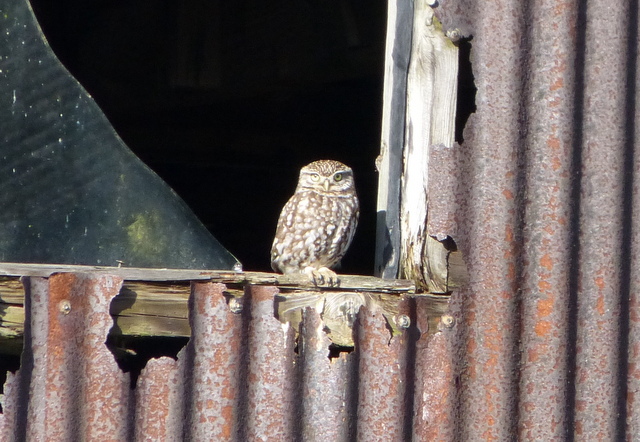 Little Owl – one of the two catching the sun here this morning
Little Owl – one of the two catching the sun here this morning
From there we headed up to Titchwell. On the way, we stopped to admire a field full of Brown Hares. There were at least ten in one large block of winter wheat today, chasing each other round, but no boxing while we were there. As we climbed out of the car at Titchwell, a Red Kite flew overhead, west over the car park. It stopped to circle over the trees, before heading off along the coast.
It may only be February, but birds are on the move already. Some of our winter visitors are already leaving (or have left!), and others are gathering in sight of the coast, staging, in anticipation of making the journey further north. A lot of the Pink-footed Geese have already departed, but there were small groups flying west along the coast all day today. They are probably heading up to Scotland now, where they will stop for a while before making the journey onwards to Iceland to breed.
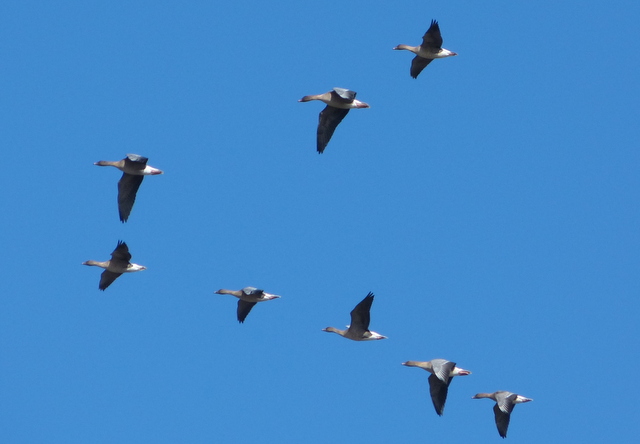 Pink-footed Goose – small groups were moving overhead all day today
Pink-footed Goose – small groups were moving overhead all day today
As usual, the reserve at Titchwell provided the opportunity to observe an excellent selection of waders. The drained grazing marsh pool held a Ringed Plover and a couple of Redshank, and a small group of Dunlin flew in just as we moved on. There was a nice group of Avocet out on the freshmarsh, though they were roosting with their feet wet, given the continued high water levels.
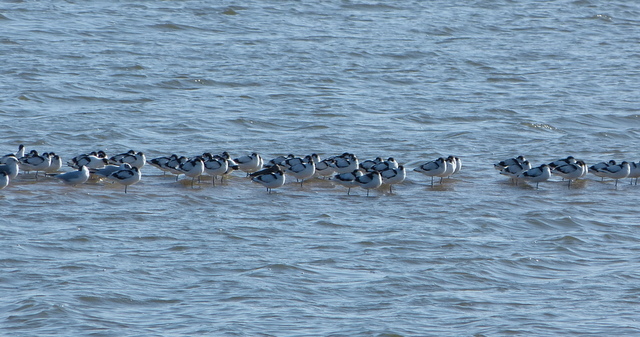 Avocet – roosting on the still-flooded freshmarsh
Avocet – roosting on the still-flooded freshmarsh
The few remaining small bits of island still showing above the flood also held a few Dunlin, plus several Lapwing, a Turnstone and a Grey Plover. However, the Volunteer Marsh had more variety – more of the same, plus Oystercatcher, Curlew, Black-tailed Godwit, several Knot. A Spotted Redshank flew over calling, but unfortunately didn’t drop in. On the tidal pools, we added Bar-tailed Godwit. Out on the beach, a little group of Sanderling were chasing in and out of the waves as they broke on the sand. As we walked back later, a single Greenshank had dropped in to the Volunteer Marsh on the rising tide and fed along the edge of one of the channels.
 Black-tailed Godwit – there was a great selection of waders at Titchwell today
Black-tailed Godwit – there was a great selection of waders at Titchwell today
There was also a good selection of wildfowl to be seen. Out on the freshmarsh, the ducks and geese were enjoying the raised water levels. A large flock of Brent Geese had flown in from the saltmarsh to bathe and preen. Numbers of ducks were down on recent weeks, but there were still plenty of Teal, plus a smattering of Wigeon and Shoveler and a handful of Gadwall. There were several Pintail as well, although they were hiding at the back – we got better views of a small group a little further along, out on the tidal pools. The reedbed pool held a few Pochard and Tufted Duck.
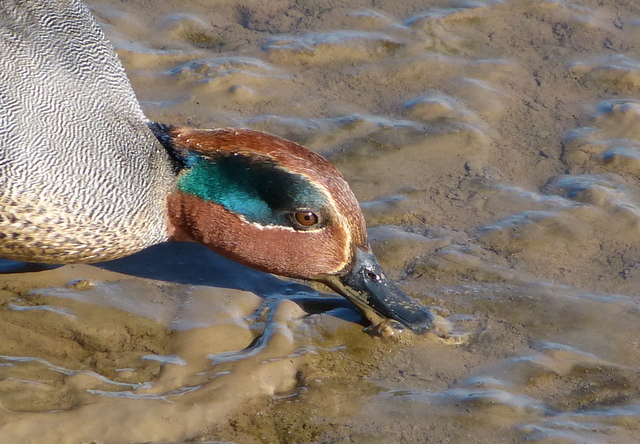 Teal – a stunning male, feeding in the mud on the Volunteer Marsh
Teal – a stunning male, feeding in the mud on the Volunteer Marsh
There were fewer ducks as well out on the sea than in recent weeks. There was still a decent raft of Common Scoter and a few Goldeneye, but we couldn’t find anything else today. A Red-throated Diver flew past and a Great Crested Grebe was diving further out.
The feeders around the Visitor Centre are always alive with tits and finches. We stopped to scan them and a burst of twittering song from the alders nearby caught our attention. After a little bit of searching, we located the source – a couple of very smart male Siskin. Then it was back to the car for lunch, to the sound of the Bullfinches calling from the sallows and with little groups of Golden Plover passing west overhead.
The rest of the afternoon was spent at Burnham Overy. As soon as we got out of the car, a Barn Owl floated silently over the road beside us and started to hunt along the grassy margin of the field opposite. Great to watch and a sign of things to come!
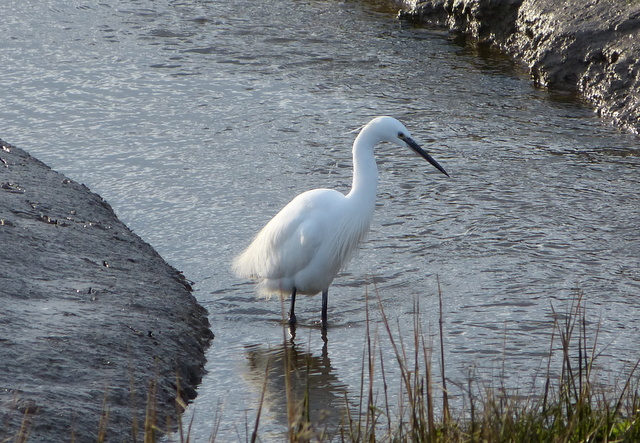 Little Egret – feeding in one of the saltmarsh channels on the falling tide
Little Egret – feeding in one of the saltmarsh channels on the falling tide
As usual, the grazing marshes on the walk out were alive with waders. The large flocks of Lapwing and Golden Plover were whirling round all the time, seemingly spooked by any sudden movement overhead, friend or foe. There were lots of Curlew and, in amongst them, we found a couple of much smaller Ruff. The flooded dips in the grass were ringed with little groups of diminutive Dunlin. Once we got up onto the seawall, there were even more waders out on the saltmarsh.
There were still plenty of geese out on the grazing marshes, but the numbers now are dominated by Brent Geese. Most of the Pink-footed Geese have departed already, but still some small groups remained out on the grass. As we had seen in the morning, more Pinkfeet were still heading west overhead.
Suddenly all the birds behind us took off, the large flocks of Wigeon particularly noisily. We looked round just in time to see a sleek, streamlined shape powering towards us. A small, male Peregrine shot through, down over the reeds and low across the grass towards the Golden Plover flock by the dunes, scattering everything as it went. Interestingly, on our walk back later we were to see exactly the same thing again – it has obviously identified a lucrative food source out on the marshes here.
That was not the only raptor to be seen here. As well as several Marsh Harriers and Kestrels, it didn’t take us long to locate one of the wintering Rough-legged Buzzards, out on one of its favoured posts across the other side of the grazing marshes. A pale Common Buzzard perched on a nearby post provided a useful highlight of the pitfall of Rough-legged Buzzard identification – the Common Buzzard being strikingly creamy-white on head and underparts, but clearly lacking the contrasting black belly patch of its rarer cousin. While we were scanning the marshes, the second Rough-legged Buzzard appeared over the pines and dropped down to land in the dunes, its very pale head and dark belly standing out even at a distance. We walked over into the dunes to get a better look at it through the scope.
 Rough-legged Buzzard – one of two today, this one perched up in the dunes
Rough-legged Buzzard – one of two today, this one perched up in the dunes
However, the afternoon really belonged to the owls. Holkham and Burnham Overy are often good for Barn Owl, but we had an amazing performance from them today. After the one we had seen on arrival, we picked up a couple more distantly from the seawall, looking towards the pines. Then one appeared in front of us and proceeded to hunt over the seawall itself, where it dropped down suddenly into the grass. The local Kestrel came over for a look and landed a couple of metres away, where the two engaged in a stare-off. As the Barn Owl took off again, we could see it had caught a vole. The Kestrel wouldn’t leave it alone and set off in pursuit, swooping down at it until the Barn Owl dropped into the reeds. The Kestrel then gave up and when the Owl reappeared the vole had gone – hopefully eaten!
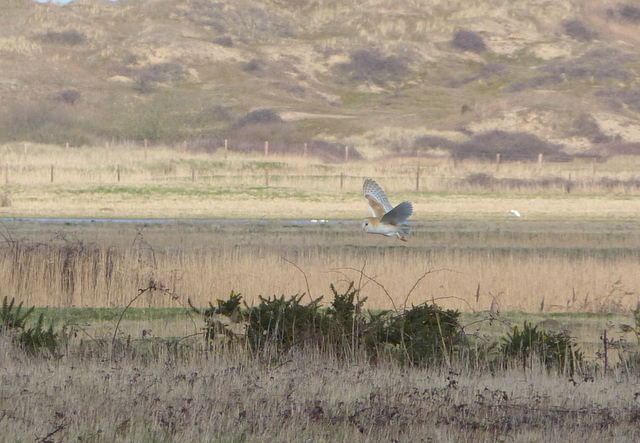
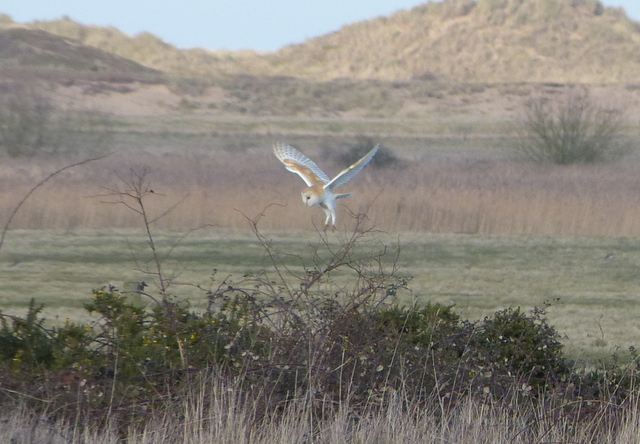 Barn Owl – there were at least six hunting over the grazing marsh today
Barn Owl – there were at least six hunting over the grazing marsh today
There were so many Barn Owls, it was hard to count them all properly. There were at least six in view at one time, so probably more in total out hunting. Eventually the Short-eared Owl appeared – bigger, longer-winged, and better camouflaged than its smaller cousins. It was hunting a bit further over, towards the pines today, but we got great views of it through the scope, quartering back and forth on its stiff wings. From out in the dunes, we could see it hiding in the grass, looking round furtively all the time, its yellow irises flashing in the late afternoon sunlight.
As the light started to fade, we walked back, stopping to admire the view across the saltmarsh as the sun descended to the west. Another great day of winter birding, with a very respectable list of around 90 species for the day, as well as plenty of owls. Not bad!

















